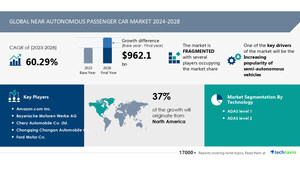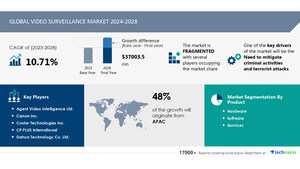NEW YORK, Nov. 14, 2024 /PRNewswire/ -- Report on how AI is redefining market landscape - The global facial recognition market size is estimated to grow by USD 11.82 billion from 2024-2028, according to Technavio. The market is estimated to grow at a CAGR of over 22.2% during the forecast period. Increasing instances of identity threats is driving market growth, with a trend towards technological advances and emergence of facial analytics. However, high cost of deployment poses a challenge.Key market players include Amazon.com Inc., ASSA ABLOY AB, Aware Inc., Ayonix Pty Ltd., Cognitec Systems GmbH, Daon Inc., Facebanx, FaceFirst Inc., Fujitsu Ltd., IDEMIA France SAS, Ipsidy Inc., Luxand Inc., Microsoft Corp., NEC Corp., Precise Biometrics AB, Safran SA, Suprema Inc., Synaptics Inc., Thales Group, and Veridium IP Ltd..
Key insights into market evolution with AI-powered analysis. Explore trends, segmentation, and growth drivers- View Free Sample PDF
Facial Recognition Market Scope |
|
Report Coverage |
Details |
Base year |
2023 |
Historic period |
2018 - 2022 |
Forecast period |
2024-2028 |
Growth momentum & CAGR |
Accelerate at a CAGR of 22.2% |
Market growth 2024-2028 |
USD 11819.9 million |
Market structure |
Fragmented |
YoY growth 2022-2023 (%) |
17.9 |
Regional analysis |
North America, Europe, APAC, Middle East and Africa, and South America |
Performing market contribution |
North America at 37% |
Key countries |
US, China, UK, Germany, and Japan |
Key companies profiled |
Amazon.com Inc., ASSA ABLOY AB, Aware Inc., Ayonix Pty Ltd., Cognitec Systems GmbH, Daon Inc., Facebanx, FaceFirst Inc., Fujitsu Ltd., IDEMIA France SAS, Ipsidy Inc., Luxand Inc., Microsoft Corp., NEC Corp., Precise Biometrics AB, Safran SA, Suprema Inc., Synaptics Inc., Thales Group, and Veridium IP Ltd. |
Facial recognition market is witnessing significant growth in various sectors including attendance tracking in educational institutions, patient identification in healthcare settings, and automating payment systems in retail. Operational efficiency is a key driver for organizations in education, healthcare, and retail sectors to adopt facial recognition technology. Security is another major factor, with surveillance systems being implemented in airports, critical infrastructure sectors, and public spaces to mitigate security threats and criminal activities. NEC, Microsoft, AWS, and other tech giants dominate the market with their KYC systems and digital wallets. Facial recognition is also used for authentication and security in mobile devices, mobile payments, app access, and identity verification. However, vulnerability to hacking, deep fakes, and cyber threats pose challenges to the market. Biases in facial recognition algorithms and privacy concerns are also areas of concern. The market includes companies like NEC Corporation, NtechLab, MorphoTrust, IDEMIA, Rekognition, FacePhi, Ayonix Corporation, Creditel, Salto Group, Cognitec Systems, and Secunet. Sectors like police enforcement, banking, law enforcement, forensic investigation, border control, access management, and consumer experiences are also impacted by this technology. Artificial intelligence, deep learning algorithms, computer vision, high-resolution cameras, and contactless authentication techniques are key technology trends. Data security, biases, and privacy are impacting factors.
The facial recognition market is experiencing significant growth due to technological advancements. Vendors are integrating facial recognition technology into video surveillance systems, enabling easier and effective identification of intruders or attackers. This enhancement boosts security levels, addressing the increasing security concerns worldwide. Governments are increasing their spending on surveillance devices in response to heightened intruder threats. Vendors provide facial recognition capabilities as standalone or integrated software solutions with video surveillance systems.
Request Sample of our comprehensive report now to stay ahead in the AI-driven market evolution!
• Facial recognition technology is revolutionizing various sectors including attendance tracking in educational institutions, patient identification in healthcare settings, and automating payment systems in retail. Operational efficiency is a key driver for organizations in the education, healthcare, and retail sectors to adopt this technology. However, challenges persist. Security threats such as privacy concerns, illegal monitoring, and vulnerability to hacking are major issues. Sectors like law enforcement, banking, and border control rely on facial recognition for identification and verification. Technology leaders like NEC, Microsoft, AWS, and biometric experts such as NtechLab, MorphoTrust, IDEMIA, Rekognition, FacePhi, Ayonix Corporation, Creditel, Salto Group, and Cognitec Systems are at the forefront of this market. Biases, deep fakes, and cyber threats are also concerns. Facial recognition is used in physical security, public safety, and access control. It impacts consumer experiences through smartphone applications and contactless authentication techniques. Artificial intelligence, deep learning algorithms, and computer vision are essential for high-resolution cameras and 2D/3D facial analytics. Despite challenges, the future of facial recognition is promising, with applications in emotion recognition, security and surveillance, retail and e-commerce, media and entertainment, automobile and transportation, and IT and telecom.
• Facial recognition technology offers significant benefits for security and identification in various industries, including government and transportation. However, the high cost of deployment is a major challenge. Large-scale implementation in departments and airports involves a lengthy sales cycle and significant investment. Costs extend beyond the facial recognition solution itself, with additional expenses for maintenance, middleware, and other associated costs. Budget constraints can result in substantial losses if implementation fails. Despite these challenges, the potential benefits of facial recognition make it a worthwhile investment for businesses seeking enhanced security and efficiency.
Discover how AI is revolutionizing market trends- Get your access now!
This facial recognition market report extensively covers market segmentation by
- Application
- 1.1 Identification
- 1.2 Verification
- Technology
- 2.1 3D
- 2.2 2D
- 2.3 Facial analytics
- End-user
- 3.1 Media & entertainment
- 3.2 BFSI
- 3.3 Automobile & transportation
- 3.4 Others
- Geography
- 4.1 North America
- 4.2 Europe
- 4.3 APAC
- 4.4 Middle East and Africa
- 4.5 South America
1.1 Identification- The facial recognition market for identification is experiencing significant growth due to its increasing adoption in sectors such as government and transportation. This technology enables the matching of an individual's facial features with a database to retrieve their details, eliminating the need for human interaction. Its implementation in security purposes, particularly in public places and airports, is driving its growth. In the US, companies like Delta Airlines use facial recognition for passenger check-ins, and airports are adopting this technology for passenger identification. The integration of facial recognition with video surveillance systems is also supporting market growth. The security sector's growing reliance on facial recognition is expected to boost the identification segment and the global market as a whole during the forecast period.
Download a Sample of our comprehensive report today to discover how AI-driven innovations are reshaping competitive dynamics
The Facial Recognition market is a rapidly growing sector of Biometrics technology, which uses Face recognition, Image recognition technology, and other Authentication techniques to identify and verify individuals based on their unique facial characteristics. This technology is increasingly being adopted across various sectors, including educational institutions for attendance tracking, healthcare settings for patient identification, and retail for automating payment systems. It offers operational efficiency for organizations by streamlining access control and surveillance. Sectors such as law enforcement and banking are also leveraging this technology for identification and security purposes. Facial recognition systems analyze facial characteristics, including the jawline, to create a unique identifier. Companies like NEC Corporation and NtechLab are leading innovators in this field, offering smart hospitality services and advanced recognition algorithms. Speech and Fingerprint recognition are other forms of Biometrics technology that complement Facial Recognition in the market.
Facial recognition technology is a biometric identification method that uses artificial intelligence and machine learning algorithms to identify and verify individuals based on their facial features. This technology is gaining popularity in various sectors including attendance tracking in educational institutions, patient identification in healthcare settings, automating payment systems in retail, operational efficiency in organizations, and security in public spaces. Facial recognition systems can be used for authentication, monitoring, and surveillance in airports, critical infrastructure sectors, and transportation hubs to ensure security and prevent criminal activities. However, privacy concerns have arisen due to the potential for illegal monitoring and vulnerability to hacking, deep fakes, and cyber threats. The technology can also be used for fraud prevention in digital wallets and smartphone applications, identity verification for app access and device unlocking, and access control in smart hospitality services. The use of facial recognition is expanding to sectors such as police enforcement, banking, law enforcement, forensic investigation, criminal identification, border control, and access management. Facial recognition technology is powered by artificial intelligence, deep learning algorithms, computer vision, and high-resolution cameras. It can be used for 3D and 2D facial analytics, emotion recognition, and security and surveillance. The technology is impacted by factors such as biases, technology advancements, and regulatory policies.
1 Executive Summary
2 Market Landscape
3 Market Sizing
4 Historic Market Size
5 Five Forces Analysis
6 Market Segmentation
- Application
- Identification
- Verification
- Technology
- 3D
- 2D
- Facial Analytics
- End-user
- Media & Entertainment
- BFSI
- Automobile & Transportation
- Others
- Geography
- North America
- Europe
- APAC
- Middle East And Africa
- South America
7 Customer Landscape
8 Geographic Landscape
9 Drivers, Challenges, and Trends
10 Company Landscape
11 Company Analysis
12 Appendix
Technavio is a leading global technology research and advisory company. Their research and analysis focuses on emerging market trends and provides actionable insights to help businesses identify market opportunities and develop effective strategies to optimize their market positions.
With over 500 specialized analysts, Technavio's report library consists of more than 17,000 reports and counting, covering 800 technologies, spanning across 50 countries. Their client base consists of enterprises of all sizes, including more than 100 Fortune 500 companies. This growing client base relies on Technavio's comprehensive coverage, extensive research, and actionable market insights to identify opportunities in existing and potential markets and assess their competitive positions within changing market scenarios.
Technavio Research
Jesse Maida
Media & Marketing Executive
US: +1 844 364 1100
UK: +44 203 893 3200
Email: [email protected]
Website: www.technavio.com/
SOURCE Technavio

WANT YOUR COMPANY'S NEWS FEATURED ON PRNEWSWIRE.COM?
Newsrooms &
Influencers
Digital Media
Outlets
Journalists
Opted In






Share this article